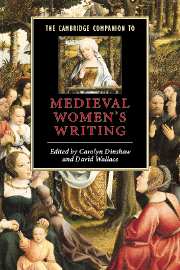Book contents
- Frontmatter
- Introduction
- Part I Estates of women
- Part II Texts and other spaces
- Part III Medieval women
- 10 Heloise
- 11 Marie de France
- 12 The Roman de la Rose, Christine de Pizan, and the querelle des femmes
- 13 Lyrics and romances
- 14 Julian of Norwich
- 15 Margery Kempe
- 16 Continental women mystics and English readers
- 17 Joan of Arc
- Further reading
- Index
17 - Joan of Arc
from Part III - Medieval women
Published online by Cambridge University Press: 28 May 2006
- Frontmatter
- Introduction
- Part I Estates of women
- Part II Texts and other spaces
- Part III Medieval women
- 10 Heloise
- 11 Marie de France
- 12 The Roman de la Rose, Christine de Pizan, and the querelle des femmes
- 13 Lyrics and romances
- 14 Julian of Norwich
- 15 Margery Kempe
- 16 Continental women mystics and English readers
- 17 Joan of Arc
- Further reading
- Index
Summary
Joan of Arc, or Joan the Maid (Jeanne la Pucelle), as she called herself, exemplifies three powerful female types for the Middle Ages – prophet, virgin martyr, and androgyne – all culminating in one persona, as expressed in her writings: her letters and trial testimony. Given the form and context of her writings, her ‘readers’ almost inevitably began as her doubters, and often adversaries, in some way. A cult figure even during her brief lifetime, she understood early on, with uncanny insight for a minimally educated person, the essential reciprocity between myth and truth while formulating her mission. For each and every extraordinary attribute she claimed to possess, she could provide some kind of authentication. Such was the recurrent cycle of dialogue between past and present, prophecy and proof, governing her career as controversial saviour of France.
Whether one perceives her as cipher or seer, Joan’s entire life (1412–31) was shaped by the Hundred Years’War between France and England, begun in 1337 and eventually ending, partly thanks to her achievements, in 1453. By Joan’s time, and despite such hopeful interludes as the reign of Charles V (1368–80), this inter-dynastic struggle between violently self-determining national identities had resulted in two crushing English military victories over the French: Crécy in 1346 and Agincourt in 1415. Strife from within, among the French noble families, also weakened the kingdom, the gravest being the assassination of Louis, Duke of Orleans, by men of John the Fearless, Duke of Burgundy, in 1407. Suffering repeated bouts of insanity, Charles VI could do little to avenge his brother’s murder and maintain unity within his kingdom.
- Type
- Chapter
- Information
- The Cambridge Companion to Medieval Women's Writing , pp. 256 - 266Publisher: Cambridge University PressPrint publication year: 2003



